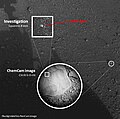File:PIA16075-Curiosity Rover ChemCam-20120819.jpg

原始檔案 (791 × 783 像素,檔案大小:100 KB,MIME 類型:image/jpeg)
摘要
| 描述PIA16075-Curiosity Rover ChemCam-20120819.jpg |
English: 08.19.2012
First Laser-Zapped Rock on Mars This composite image, with magnified insets, depicts the first laser test by the Chemistry and Camera, or ChemCam, instrument aboard NASA’s Curiosity Mars rover. The composite incorporates a Navigation Camera image taken prior to the test, with insets taken by the camera in ChemCam. The circular insert highlights the rock before the laser test. The square inset is further magnified and processed to show the difference between images taken before and after the laser interrogation of the rock. The test took place on Aug. 19, 2012. In the composite, the fist-sized rock, called "Coronation," is highlighted. Coronation is the first rock on any extraterrestrial planet to be investigated with such a laser test. The widest context view in this composite comes from Curiosity's Navigation Camera. The magnified views in the insets come from ChemCam's camera, the Remote Micro-Imager. The area shown in the circular inset is 6 centimeters (2.4 inches) in diameter. It was taken before the rock was hit with the laser. The area covered in the further-magnified square inset is 8 millimeters (about one-third of an inch) across. It combines information from images taken before and after the test, subtracting the "before" image from the "after" image to make the changes in the rock visible. Curiosity's Chemistry and Camera instrument (ChemCam) inaugurated use of its laser when it used the beam to investigate Coronation during Curiosity's 13th day after landing. ChemCam hit Coronation with 30 pulses of its laser during a 10-second period. Each pulse delivered more than a million watts of power for about five one-billionths of a second. The energy from the laser excited atoms in the rock into an ionized, glowing plasma. ChemCam also caught the light from that spark with a telescope and analyzed it with three spectrometers for information about what elements are in the target. This initial use of the laser on Mars served as target practice for characterizing the instrument but may provide additional value. Researchers will check whether the composition changed as the pulses progressed. If it did change, that could indicate dust or other surface material being penetrated to reveal different composition beneath the surface. ChemCam was developed, built and tested by the U.S. Department of Energy's Los Alamos National Laboratory in partnership with scientists and engineers funded by France's national space agency, Centre National d'Etudes Spatiales (CNES) and research agency, Centre National de la Recherche Scientifique (CNRS). NASA's Jet Propulsion Laboratory, a division of the California Institute of Technology, Pasadena, manages the Mars Science Laboratory Project, including Curiosity, for NASA's Science Mission Directorate, Washington. JPL designed and built the rover. Image Credit: NASA/JPL-Caltech/LANL/CNES/IRAP |
| 日期 | |
| 來源 | http://photojournal.jpl.nasa.gov/jpeg/PIA16075.jpg |
| 作者 | NASA/JPL-Caltech/LANL/CNES/IRAP |
| 其他版本 | http://photojournal.jpl.nasa.gov/catalog/PIA16075 |
授權條款
| Public domainPublic domainfalsefalse |
| 本作品由NASA創作,屬於公有領域。根據NASA的版權政策:“NASA的創作除非另有聲明否則不受版權保護。”(參見:Template:PD-USGov/zh,NASA版權政策或JPL圖像使用政策) |  | |
 |
警告:
|
說明
在此檔案描寫的項目
描繪內容
5 9 2012
檔案歷史
點選日期/時間以檢視該時間的檔案版本。
| 日期/時間 | 縮圖 | 尺寸 | 使用者 | 備註 | |
|---|---|---|---|---|---|
| 目前 | 2012年9月5日 (三) 20:51 |  | 791 × 783(100 KB) | Drbogdan | User created page with UploadWizard |
檔案用途
下列頁面有用到此檔案:
全域檔案使用狀況
以下其他 wiki 使用了這個檔案:
- en.wikipedia.org 的使用狀況
- ru.wikipedia.org 的使用狀況
- sr.wikipedia.org 的使用狀況

